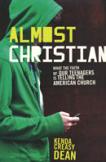Teen Spirit
The National Study of Youth and Religion is the most comprehensive study to date of teenagers and faith in the United States. Under the direction of Christian Smith of the University of Notre Dame, and funded by the Lilly Endowment, the study surveyed well over 3,000 young persons. The first fruit of that study was the now-famous book by Smith with Melinda Lundquist Denton, Soul Searching: The Religious and Spiritual Lives of American Teenagers (Oxford University Press, 2005). The study is presently generating many additional books that will help set the standard for discussion of faith and youth culture for the next decade or more. The latest entry in this literature is Almost Christian: What the Faith of Our Teenagers Is Telling the American Church, by Kenda Creasy Dean of Princeton Theological Seminary. One of the leading theologians of youth culture, Dean served on the original N.S.Y.R. interview team.
In Almost Christian, the author gives an impassioned theological interpretation of Soul Searching and related studies on the state of youth and religion. This is the first book to go beyond what religiously-informed social science says about the N.S.Y.R. data toward a broader theological interpretation. Dean argues that the deep crisis of the missiological imagination of the church is the chief theological matter revealed in this research. Only a renewed missiology emerging from local church practices can address the grim challenge presented by studies of teen faith. (Disclosure: Dean and I have discussed the study’s findings in some detail, separate from this book.)
What is that challenge? Moralistic Therapeutic Deism, a term coined by Smith and Denton in Soul Searching. This is the operative religion of most teenagers in the United States (especially of young Catholics). Its “doctrines” are that religion exists to make people into good persons, God shows up only to help in personal crises, and niceness is the most desirable trait of all. In other words, this is a functional religion of “whatever works,” so long as one does not criticize or become criticized by others for one’s choices or beliefs. This characterization of early 21st-century youth has already become an influential model in academic and pastoral discussion of youth culture.
Dean accepts the accuracy of the diagnosis, and underscores the related finding that parents are the greatest influences on teens’ religiosity. Therefore this deism is much more the problem of the adult American church than of teens, and for Dean it is fundamentally at odds with orthodox Christian-ity. Against M.T.D., Dean takes two overlapping theological tracks. First, she describes church-sustaining practices like studying Scripture, moral accountability to a community, self-denial and explicit talk (and love) of Jesus. These practices are consistent, she argues, with a normative Christian doctrinal story that is fundamentally in conflict with teens’ deism, because it undercuts all self-seeking American spirituality. Authentic church practices make known a Trinitarian God who desires to share our humanity through Jesus Christ, his dying for us and rising in joy. This saving action allows the courage and creativity of the Holy Spirit to find ever new occasions for us to love God and neighbor. This can be seen in the classic saints of the tradition as much as in the unheralded activities of struggling but faithful youth ministries.
Dean’s second theological track consists in creatively showing how the small minority of religiously active and informed teens do what they do. What sort of theological lives do they lead, and what message do they bear for the larger church? The national study found that Mormons are the most religiously committed and active youth in the United States. Dean devotes an interesting chapter to exploring what makes Mormon faith-education so effective, and then relates those findings to other highly committed youth, such as conservative and African-American Protestants. She finds four qualities that highly “generative” religious youth share: claiming a creed; belonging to a community; pursuing a larger purpose; and harboring a specific hope that draws them forward. These theological “tools” highlight the difference between orthodox church culture and M.T.D. culture as conflicting ways to imagine what life and church are all about.
This readable, jargon-free book could be profitably read alongside Soul Searching or other related books, so that readers can see how Dean moves between social science and theology. It is filled with scriptural examples, written with the sober insight of one who cares deeply for the church. Its clarion missiological call will encourage readers to define their own stance, and the author’s challenge to how youth and adults live Christianity should be a conversation-starter in Christian secondary and higher education, local congregations and campus ministries.
It would strengthen the argument if Dean conceded more theological agency to those who embrace moralistic therapeutic deism. She tends to use M.T.D. as a conceptual category instead of theologically parsing actual statements made by teens (or adults). But perhaps most profitable of all is the last chapter, which reconsiders all that comes before. There Dean makes a confession of sorts regarding the “defeat” she feels at the ascendance of M.T.D., and thinks out loud about balancing her understanding of the Gospel with the importance of honoring the integrity of others’ lives and values. This chapter has a lot of love and loss in it, and seems to capture most nakedly the mood of the book as a whole. I wonder what Almost Christian would have been like if Dean had begun there. No one who cares about young Christians today, however, will be indifferent to her defense of a generous Christian particularity. This is true even if one feels sympathetic, as I do, to Dean’s closing gestures beyond the “either-or” approach that characterizes most of this important book.
This article also appeared in print, under the headline “Teen Spirit,” in the November 1, 2010, issue.








